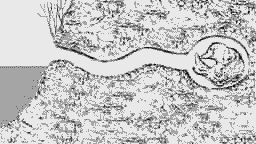Platypus Burrows
Courtesy of: The Australian Platypus Conservancy
 Platypus are air-breathing mammals, and by choice spend up to 17 hours a day resting out of the water in an underground burrow. However, they feed only in the water and are rarely observed on land for more than a few minutes at a time. Many of the platypus found in unusual locations, such as suburban gardens, appear to be young animals that are orphaned or have dispersed from their mother's home range in order to claim their own territory.
What do platypus burrows look like? Return to Platypus Page
Platypus use two types of burrows: "nesting burrows" (which provide shelter for a mother and up to three offspring) and "camping burrows" (all other burrows). In both cases, the burrow chambers are just big enough to accommodate their occupants - for example, a nesting chamber containing two young platypus (estimated to be a month old) along Lockyer Creek in Queensland was 25 centimetres wide x 46 cm long x 20 cm high, while a camping chamber known to be used by a sub adult male along Badger Creek in Victoria was 20 cm wide x 30 cm long x 14 cm high.
The tunnel leading to a camping burrow chamber is usually quite short (1-4 metres long). Camping burrow entrances are usually difficult to spot, being located underwater or just at the water's surface and often hidden by overhanging vegetation or an undercut bank.

Where are platypus burrows found? Return to Platypus Page
Platypus select burrow sites partly on the basis of bank height, with nearly all burrows found in banks rising one metre or more above the water. As well, platypus prefer to place their burrows along moderately undercut banks where substantial vegetation overhangs the water. Such banks are normally well consolidated by plant roots, so that undercutting is confined to the part of the bank extending just above (as well as below) the water surface. The amount of cover provided along the bank top by shrubs and low-growing plants has also been found to be significantly greater than expected at platypus burrows located along the Yarra River near Melbourne. Besides helping to protect platypus burrow entrances from predators, this combination of habitat characteristics reduces the likelihood that burrows are damaged by erosion.
How many burrows does a platypus use? Return to Platypus Page
An adult platypus will normally occupy several different camping burrows (up to about a dozen) within a period of a few weeks. By having numerous burrows scattered across the entire length of its home range, a platypus is always reasonably close to a safe refuge. As well, using different burrows on different days may reduce the proliferation of parasites (such as the platypus tick, Ixodes ornithorhynchi) at any one location. Two grown platypus will sometimes share a burrow at the same time, though males and females both tend to be solitary in their habits.
Do platypus rest in places other than burrows? Return to Platypus Page
Radio-tagged platypus have occasionally been found sleeping inside a hollow log at the edge of the water or within a pile of woody branches accumulated in the stream channel.
|
